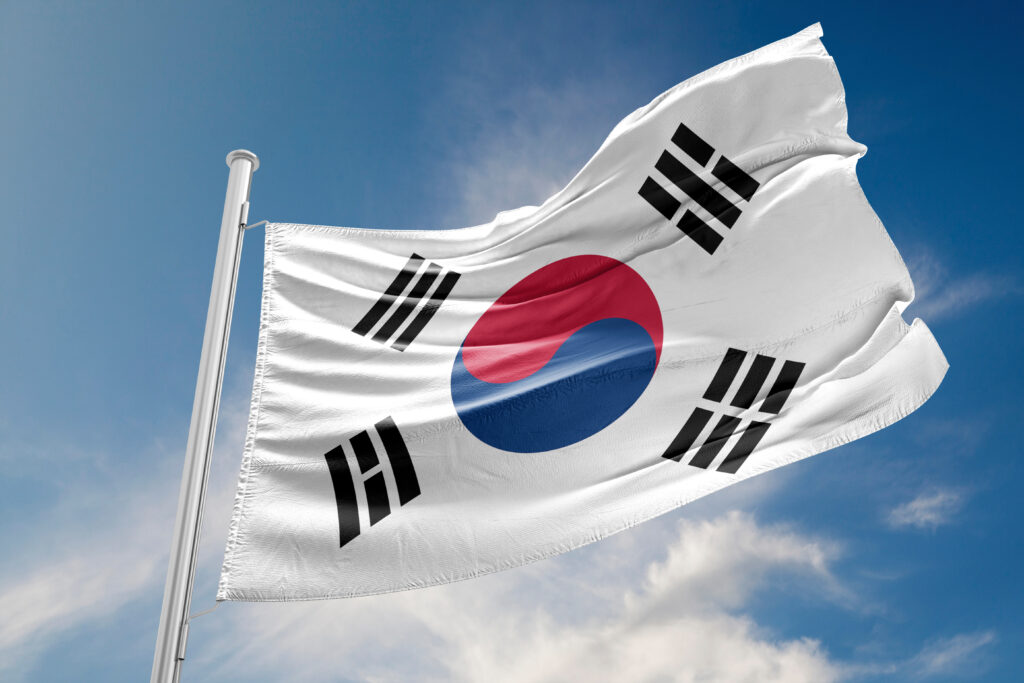
Discovering South Korea also means plunging into the fascinating world of its rich and varied cuisine. To help you make sure you don't miss out on this country's culinary nuggets, we've put together a practical, easy-to-read guide. From the must-try kimchi to tasty grilled meats, from mandu ravioli to fresh naengmyeon, we'll guide you on an exceptional culinary journey. Whether you're a gourmet or simply curious, follow us to discover the 15 South Korean specialties you won't want to miss. Get ready, your taste buds are going to travel! We also recommend our South Korean must-tries!
1- Kimchi
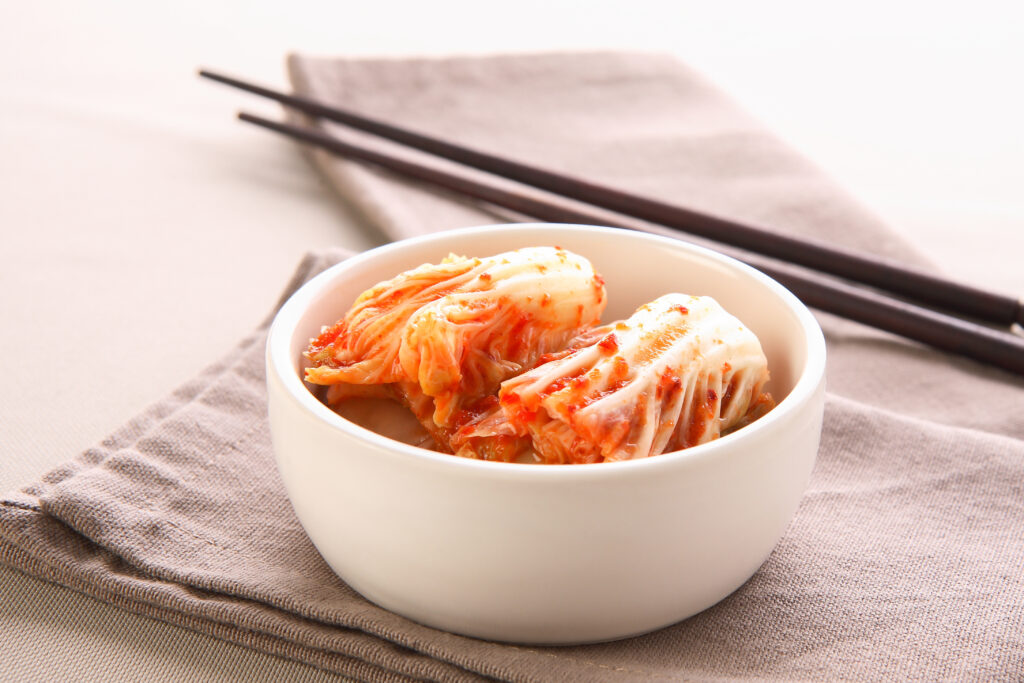
Kimchi is a classic of South Korean cuisine, present at every meal to tantalize the taste buds. It's a blend of napa cabbage and other fermented vegetables in a seasoning rich in chili, garlic and ginger. This crunchy, spicy dish doesn't just complement meals; it transforms them, delivering a dose of vitamins and health benefits. Its unique taste makes it an ideal accompaniment to both a bowl of rice and a hearty Korean barbecue. Intrigued by Korea? Discover our 3 good reasons to go to Korea!
2- Bulgogi
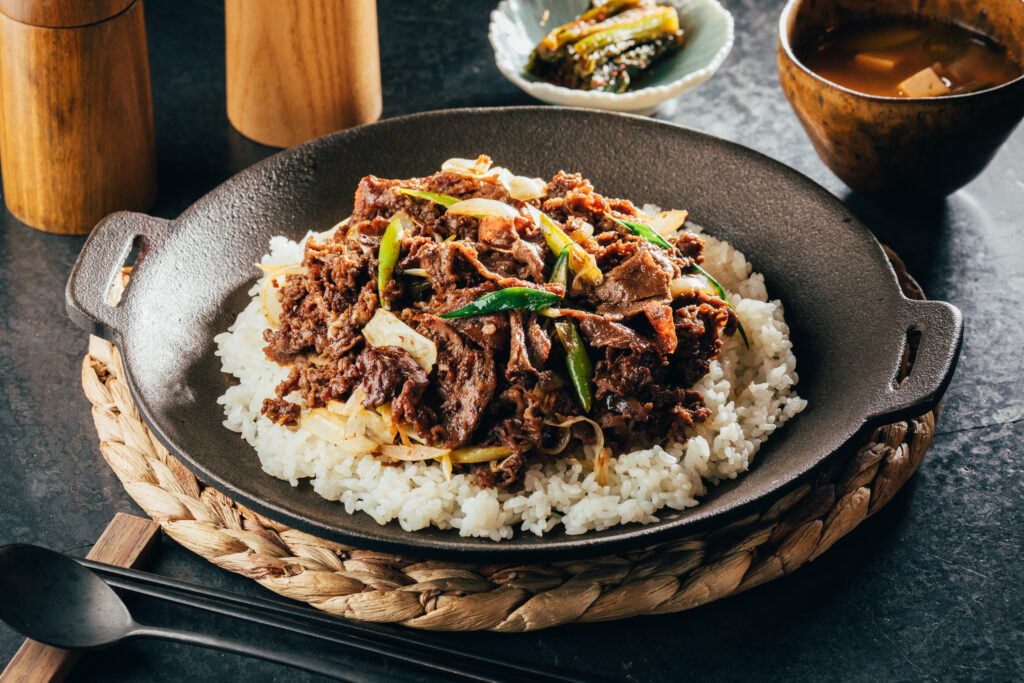
Bulgogi is famous for its sweet-savory taste and tenderness. It's a dish of thin slices of beef marinated in a sweet soy sauce, with garlic, sugar and often pear juice to tenderize the meat. These slices are then grilled to perfection. Bulgogi is enjoyed wrapped in a lettuce leaf, with a little rice and sometimes a touch of chili paste for those who like to spice things up. It's a simple yet rich experience, combining flavors harmoniously. Ideal for a meal with family or friends, bulgogi brings warmth and conviviality to the table.
3- Pajeon
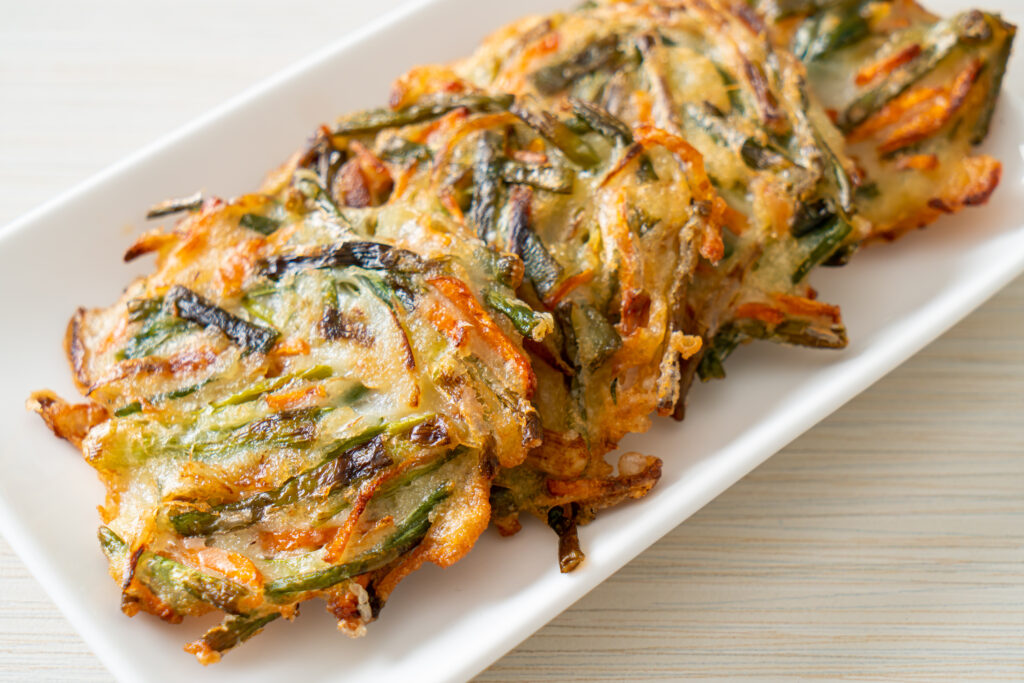
Pajeon, often called "Korean pancake", is a crunchy, comforting Korean specialty. It's a large, golden pancake filled with crunchy chunks of vegetables and sometimes seafood, such as shrimp or squid. The base is simple: flour, water and a little egg to bind it all together, but it's the addition of fresh ingredients that gives it all its character. Served hot, just out of the pan, pajeon is often accompanied by a slightly sweet-and-sour soy sauce for dipping. It's the perfect dish to share at a convivial meal, or to enjoy on a rainy day.
4- Japchae
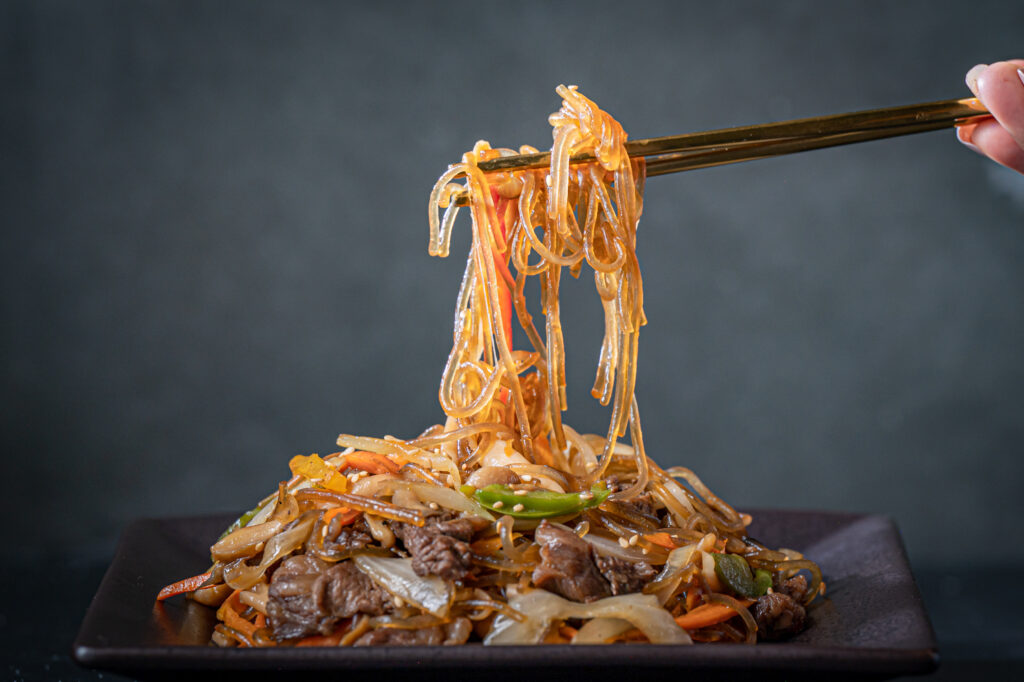
Based on transparent sweet potato noodles, japchae is garnished with sautéed vegetables such as spinach, carrots and mushrooms, and sometimes thinly sliced beef. Each ingredient is individually seasoned, then delicately blended for a perfect balance of flavors and textures. The secret of its unique taste lies in the sauce, a blend of soy sauce, sugar and sesame oil. Japchae is both a comforting and festive dish, often served on special occasions, but it's also appreciated on a daily basis. Its careful preparation and colorful presentation make it a feast for the eyes as well as the taste buds.
5- Samgyetang
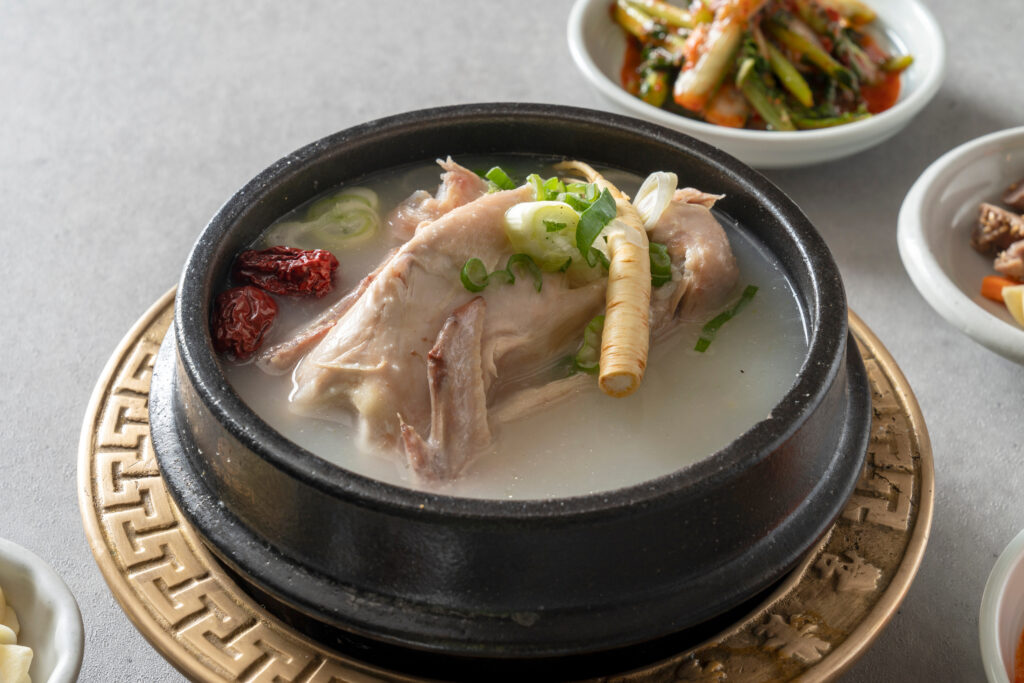
Samgyetang is a nourishing and invigorating Korean dish, perfect for recharging the batteries. This clear broth, served hot, is prepared with a small whole chicken stuffed with glutinous rice, ginseng, jujubes (Korean dates), and garlic. These ingredients are not chosen at random: they bring a wealth of flavors and are renowned for their health benefits, particularly their energizing effect. Samgyetang is particularly popular on hot summer days, following the Korean philosophy of fighting fire with fire.
6- Sundubu jjigae
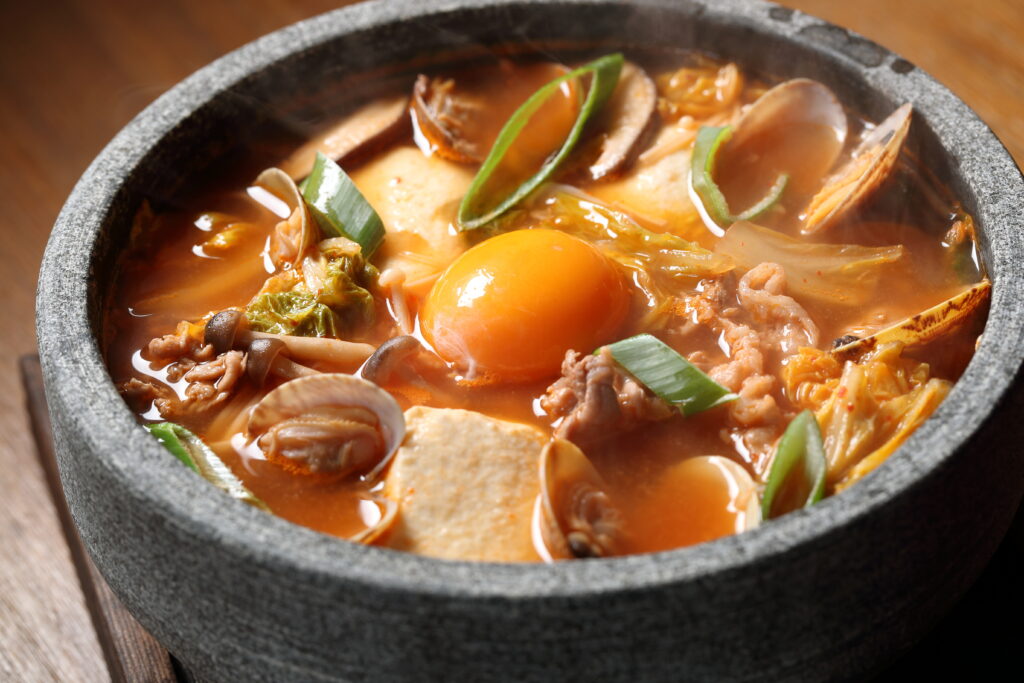
Sundubu jjigae is a sweet and spicy Korean stew, renowned for its creamy texture and comforting taste. At the heart of this dish you'll find tofu, so tender it melts in your mouth, mixed with a variety of ingredients like vegetables, seafood or meat, all swimming in a spicy chili paste broth. It's the perfect blend to warm the heart and soul, especially on cold days. Sundubu jjigae is often served boiling in a stone pot, retaining its heat throughout the meal. Easy to adapt to different tastes and diets, this dish is an ideal introduction to the richness of Korean cuisine.
7- Naengmyeon
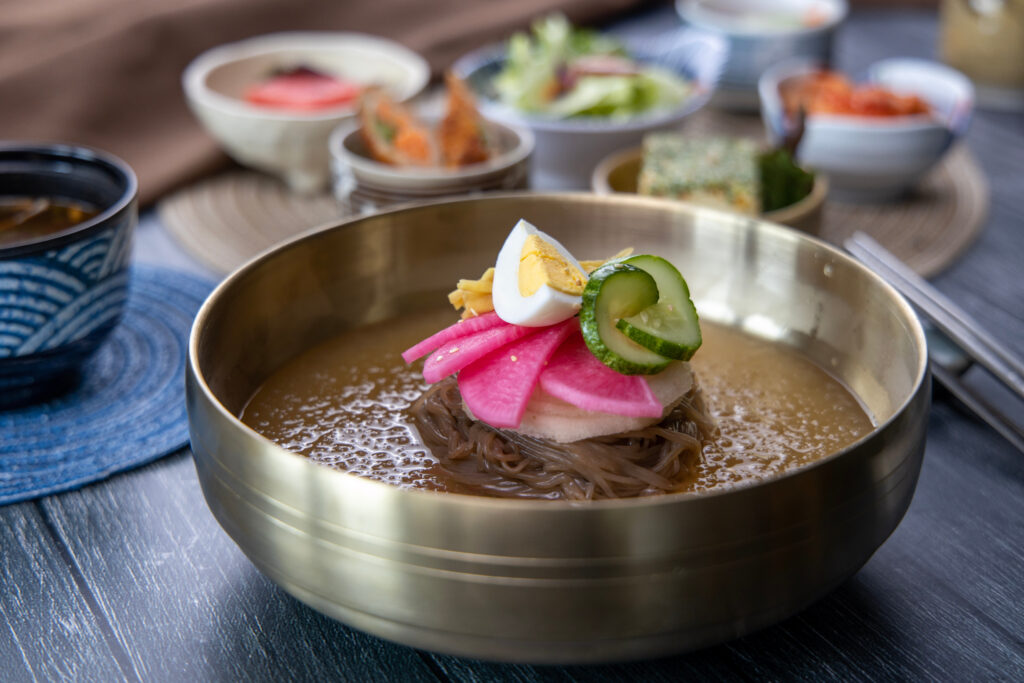
Naengmyeon is the ideal dish for hot days, a real breath of fresh air from Korea. This dish consists of thin, elastic noodles made from buckwheat, served in a glazed broth and often garnished with thin slices of beef, cucumber, pear and a hard-boiled egg. Its light but flavorful broth is often accented with a dash of vinegar or mustard to awaken the flavors. Naengmyeon offers a surprising contrast between the freshness of the broth and the richness of the fillings. It's certainly one of the dishes that best represents the interplay of temperatures and textures in Korean cuisine.
8- Bibimbap
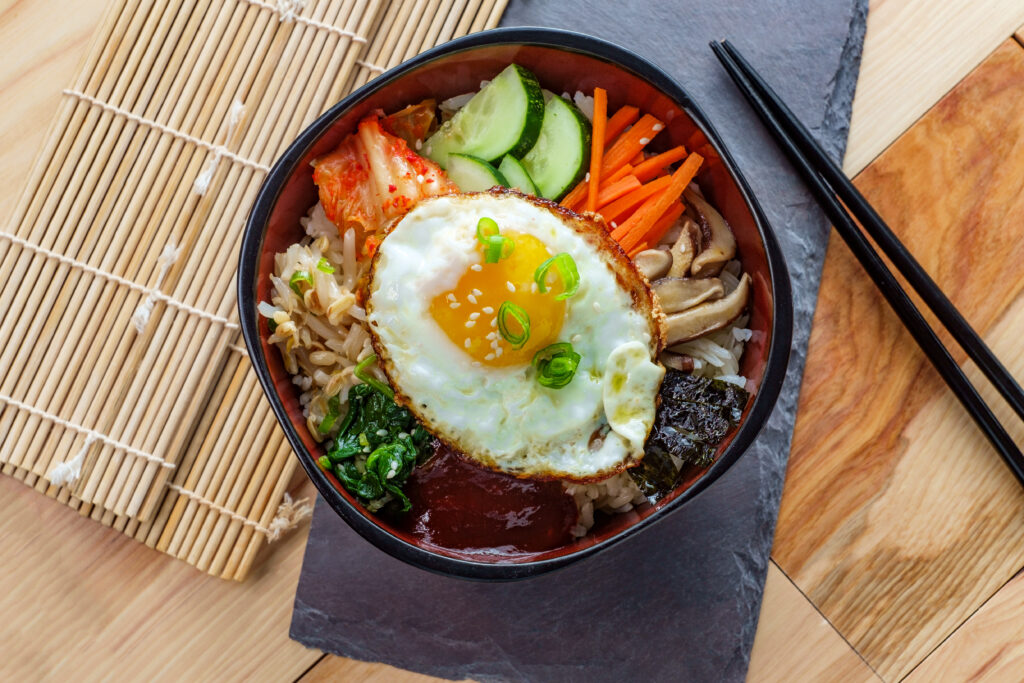
Bibimbap is one of Korea's most famous specialties. At the bottom of this bowl, you'll find a base of hot rice topped with a rainbow of sautéed vegetables, meat (often beef), and a fried egg whose runny yolk coats the whole when mixed. A spoonful of gochujang, a fermented chili paste, adds an irresistible spicy flavor. Each ingredient in bibimbap plays its part, adding texture, color and flavor for a perfect harmony in the mouth. Easy to customize according to taste and what you have on hand, it's the ideal dish for a nourishing, balanced meal full of flavor. Book your korean cooking lesson with a professional chef !
9- Mandus
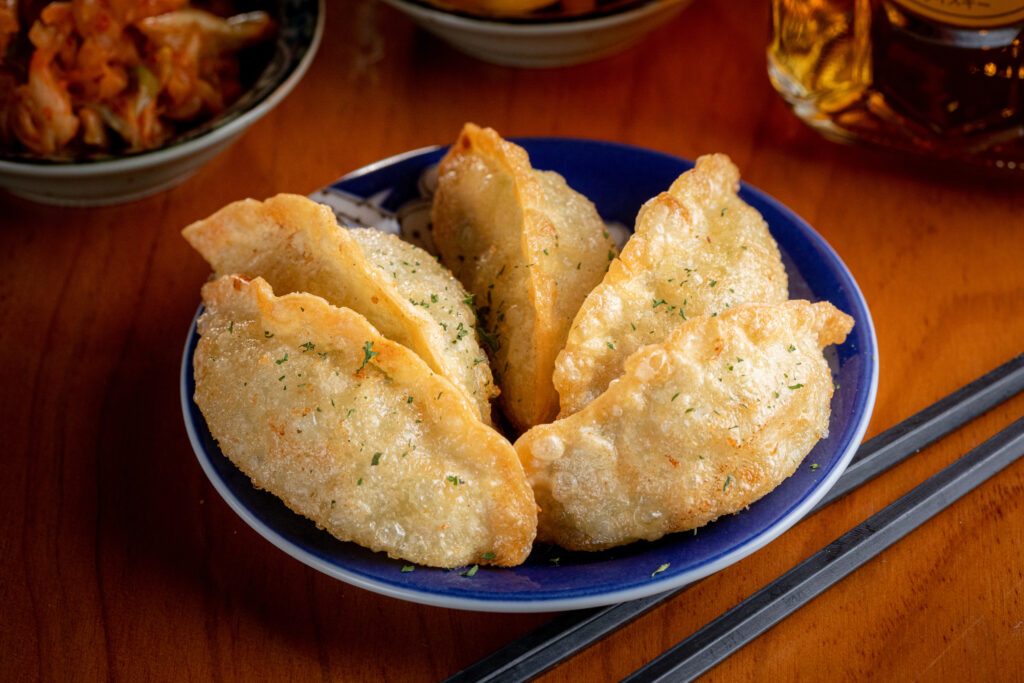
Mandus are Korean ravioli that captivate the heart and stomach from the very first bite. They are made of a thin dough enclosing a heart filled with minced meat, tofu, vegetables and sometimes sweet potato vermicelli, all skilfully seasoned. They can be steamed, boiled or even fried for a crispy touch. Served with a slightly sweet and spicy soy-based sauce, mandus are a pleasure to share, perfect for a convivial meal or festive appetizer.
10- Korean barbecue
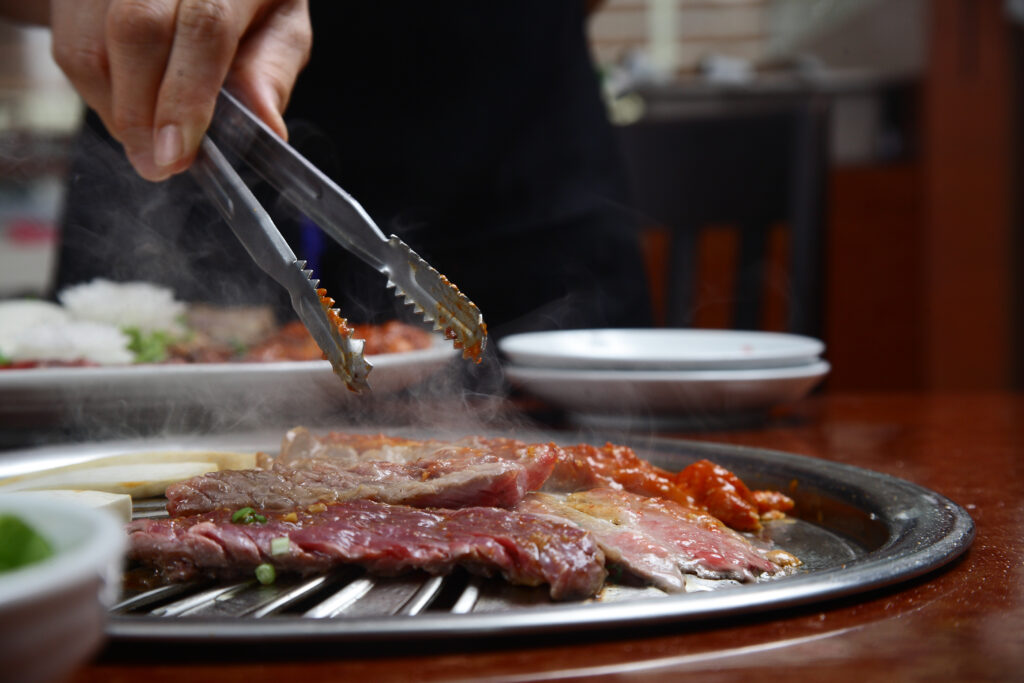
Korean barbecue, or "gogi-gui", is more than just a meal; it's a true culinary experience to be shared. Sitting around a table equipped with a grill, you' ll cook together marinated cuts of meat, such as beef, pork or chicken, to perfection. Meats are often marinated in sweet, spicy and umami blends, such as soy sauce, garlic and sugar, bringing deep, complex flavors. Alongside, fresh vegetables and a variety of accompaniments such as kimchi add freshness to the meal. Korean barbecue is not just the promise of a good meal, it's above all a moment of conviviality and sharing.
11- Gyeongdan
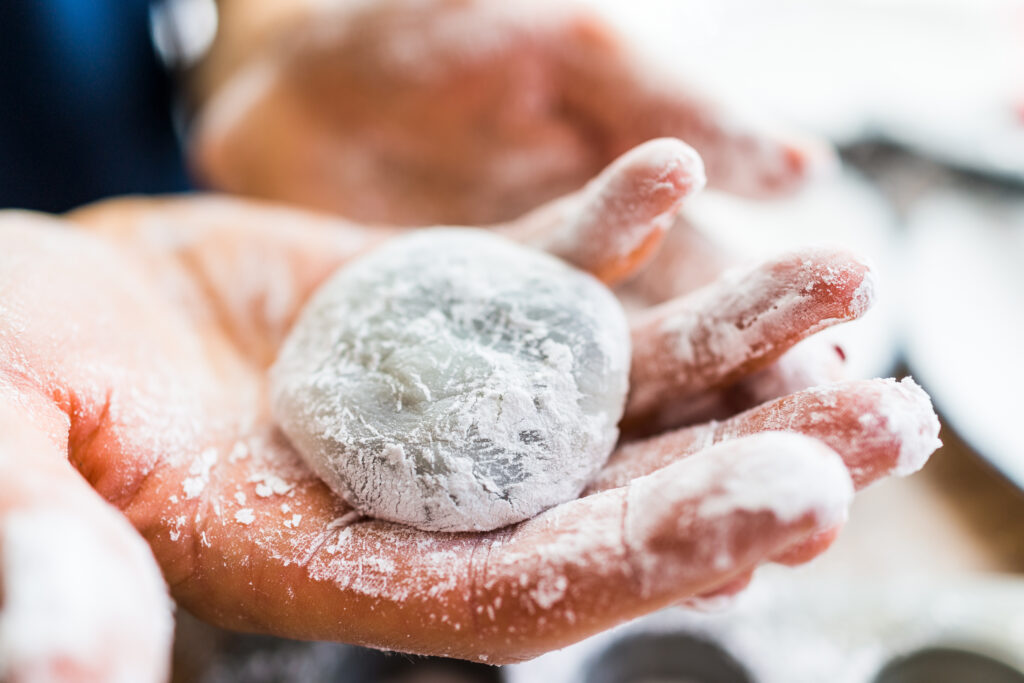
Gyeongdan are small, chewy bites of glutinous rice flour, soft to the touch and slightly sweet. They are then rolled in a variety of aromatic powders, such as toasted sesame, coconut, or even matcha for those who enjoy more modern flavors. These little treats are often prepared for special occasions, symbolizing joy and sharing. The contrast between the soft texture of the glutinous rice and the crunchy coating is the strength of this dessert. Gyeongdan are as much a feast for the eyes as for the taste buds.
12- Yakgwa
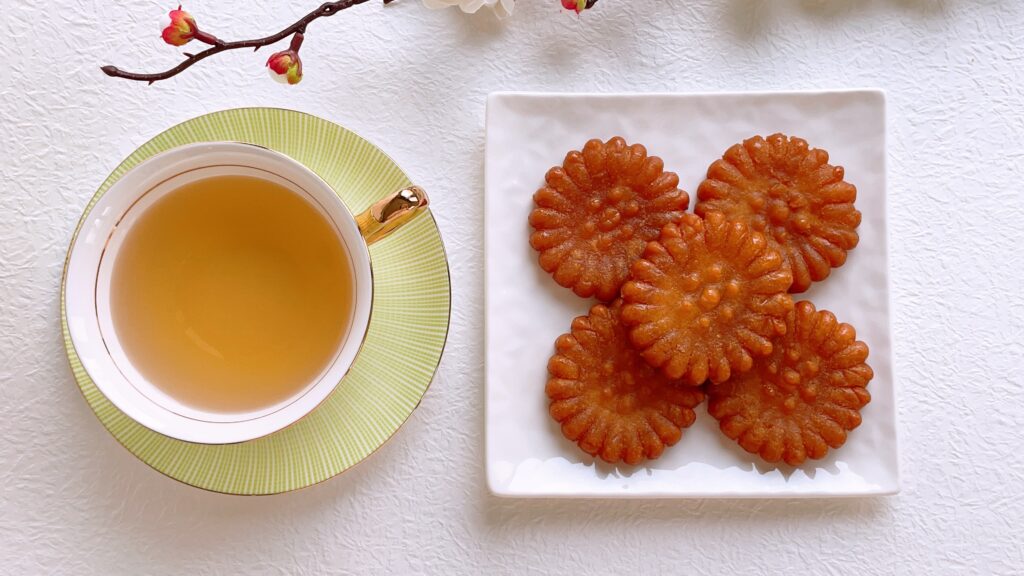
Yakgwa are a traditional Korean delicacy. They are small fried cakes made from flour, honey and sesame oil, which gives them a distinctive, rich taste. Their texture is both moist and slightly crispy, a real pleasure in the mouth. Yakgwa are often served on holidays and special occasions, symbolizing happiness and good health. These golden cakes are a treasure trove of Korean pastry, offering a window into the country's rich culinary heritage.
13- Kimbap
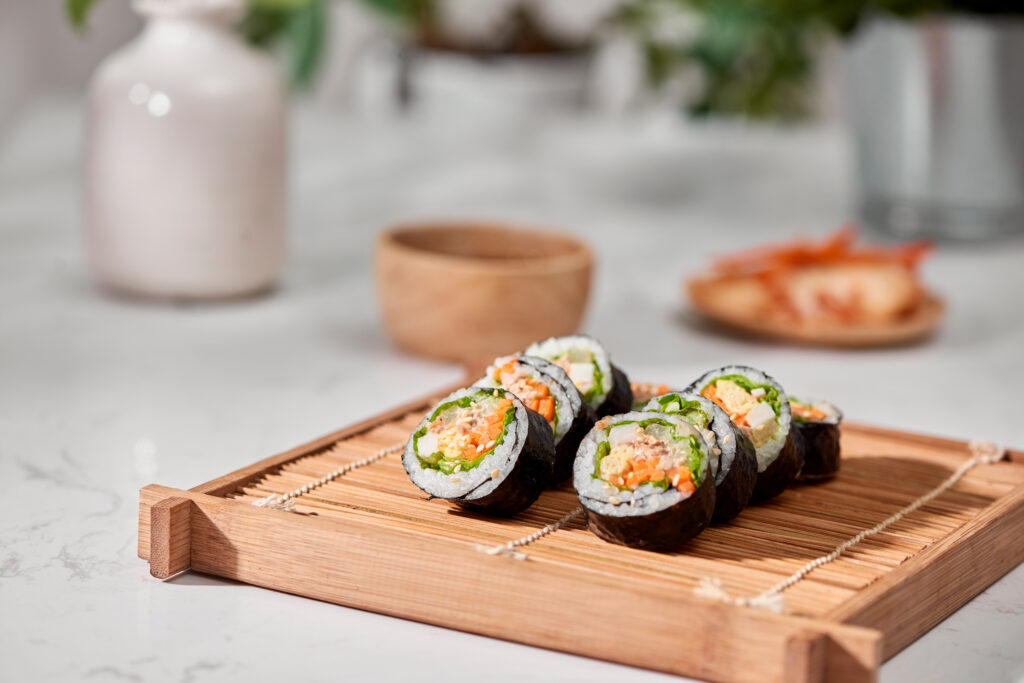
Kimbap comes in the form of rice rolls wrapped in dried seaweed leaves, similar to Japanese maki but with a uniquely Korean twist. Inside, a variety of ingredients such as fresh vegetables, scrambled eggs, and sometimes beef or tuna, create a cocktail of flavors and textures. The rice is lightly seasoned with sesame oil and salt. Easy to eat and share, kimbap are perfect for a picnic or lunch on the go. Their preparation allows great creativity, as everyone can add their favorite ingredients. These rolls are a true symbol of Korean cuisine, combining simplicity, health and pleasure.
14- Bungeoppang
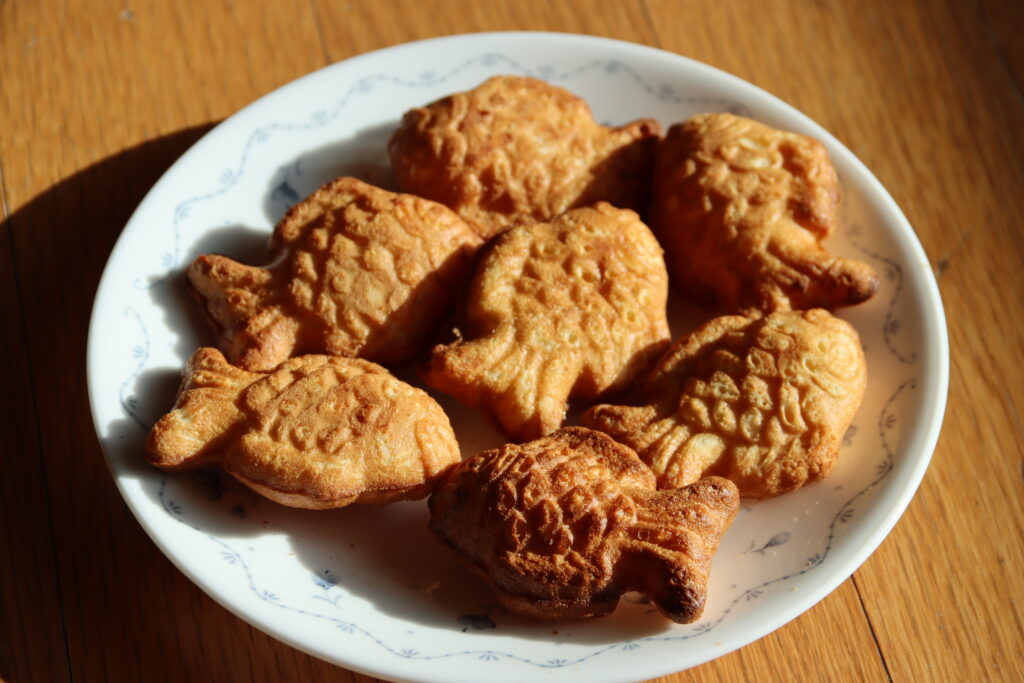
Bungeoppang is an essential Korean sweet, especially enjoyed on cold winter days. This fish-shaped cake is crispy on the outside and tenderly filled on the inside, usually with sweetened red bean paste, but sometimes also with cream or chocolate. Its fun shape and comforting taste make it a favorite with young and old alike. Bungeoppang is often sold in street stalls, creating a simple yet nostalgic taste experience. It's the ideal snack to warm hands and hearts, a little pleasure to be savored while strolling or sharing a convivial moment.
15- Hoppang
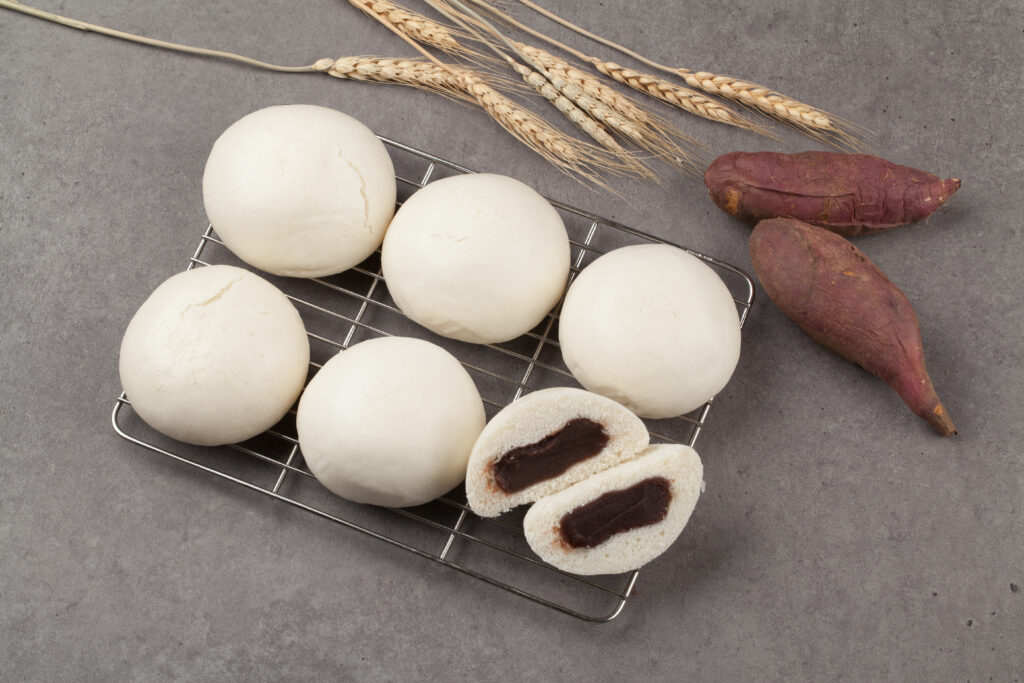
Hoppang is a Korean steamed bun, a must-have for warming up during the cold months. As soft as it is comforting, this round bun is usually filled with sweet red bean paste. Occasionally, you'll find variations filled with cream or chestnuts, each adding its own touch of flavor to the snack. Easy to take away, hoppang is most often sold in convenience stores, ready to be reheated and enjoyed at any time.
As one of the 20 most beautiful cities in the world, we recommend Seoul's must-sees to learn more about Korean culture!
Discover the hottest things to do in South Korea:
What's the typical South Korean dish?
The typical South Korean dish that stands out for its popularity and its representativeness of the local cuisine is bibimbap. This specialty consists of a rice base topped with a variety of vegetables sautéed and cooked separately, marinated meat (usually beef), and an egg, often poached or fried. The whole dish is garnished with sesame seeds or gochujang, a chili paste. Bibimbap is distinguished by its colorful presentation and can be eaten hot or cold, with many regional variants enriching its taste.
What is North Korea's national dish?
Naengmyeon, a cold noodle dish often prepared with a mixture of wheat flour and potatoes, is certainly one of North Korea's most traditional dishes. It is particularly popular and usually accompanies grilled meats, reflecting the culinary preferences and basic ingredients typical of the region.
What's a Korean favorite?
Among Korean favorites, tteokbokki (or ddeokbokki) takes pride of place. It's a dish consisting of thick rice cakes cooked in a spicy, salty and sweet sauce, often accompanied by fish cake, hard-boiled egg, cheese and so on. This popular and economical specialty is frequently sold as a street snack in Korea, reflecting Koreans' love of street food.
What is Korea's favorite drink?
Koreans' favorite drink is the iced americano, a preference revealed by their impressive consumption of coffee. In South Korea, the coffee industry is huge, with an average of 353 cups of coffee consumed per person every year. Iced americano stands out in this context for its ease of preparation, its affordability compared to other specialty drinks, and its popularity even among those who don't particularly appreciate the strong taste of coffee. The drink fits perfectly into the country's burgeoning coffee culture, where it is appreciated for its simplicity as well as its ability to provide a quick "caffeine infusion". At the same time, soju also remains an extremely popular alcoholic beverage in South Korea, famous for its versatility and ability to match a variety of dishes and occasions.
Tempted by a vacation in South Korea? Take advantage of a discount by booking your travel insurance here now, and leave with peace of mind!


